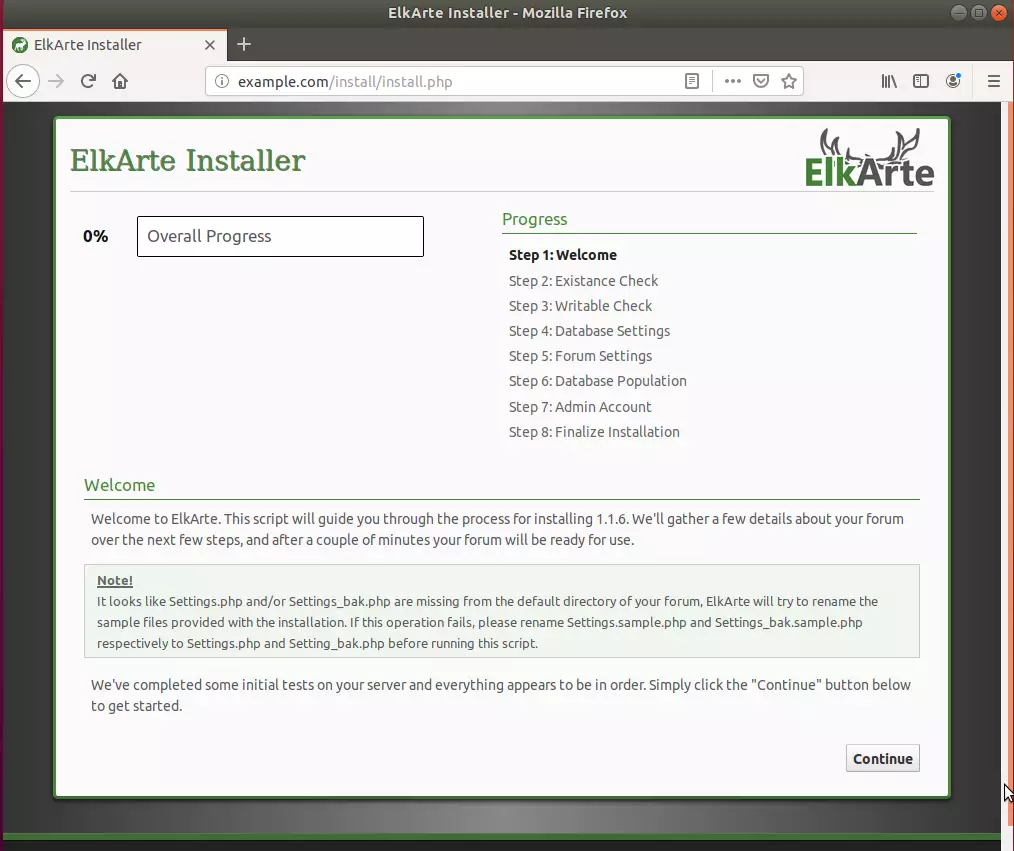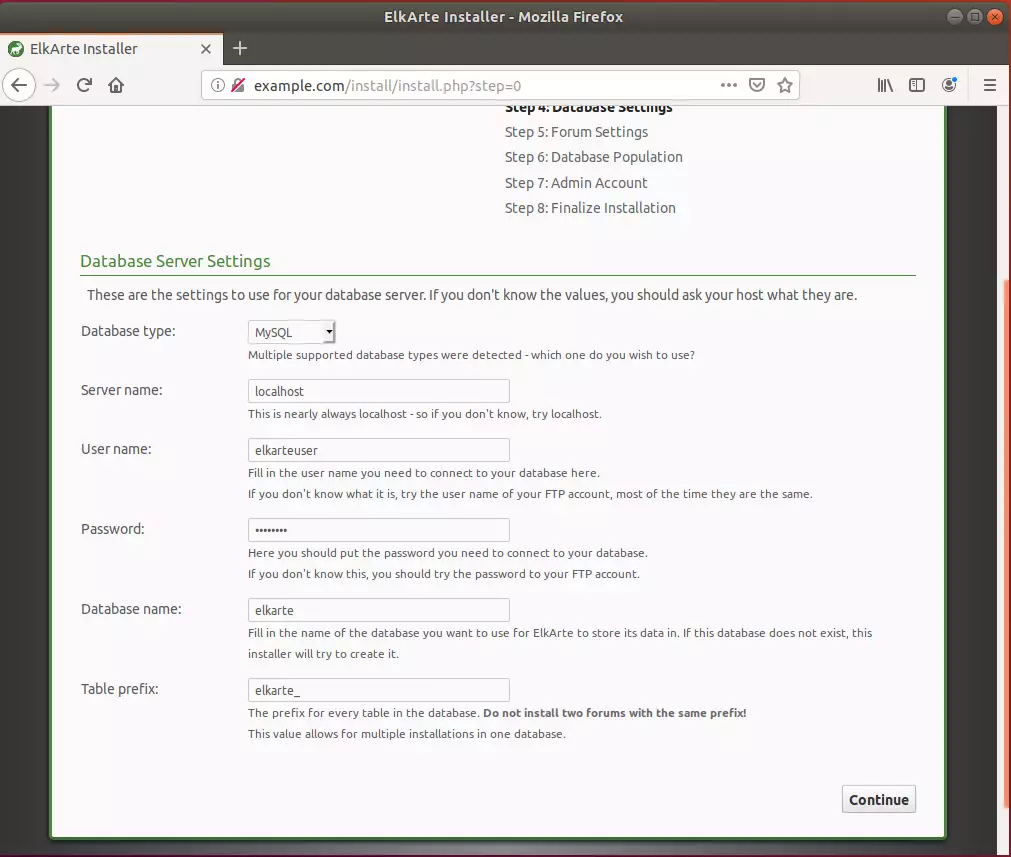This brief tutorial shows students and new users how to install and configure ElkArte Forum software on Ubuntu 18.04 with Nginx HTTP Server.
ElkArte is a modern, community-building forum software based on Simple Machine Forum (SMF), but with improved code and new features that may not be available on SMF.
If you don’t know about Simple Machine Forum (SMF), it is a lightweight and simple platform based on PHP that allows anyone to create and own their online forum community.
Many other forum software is based on SMF, including ElkArte. SMF is designed for ease of use to allow webmasters to create forum communities with all the features needed from a bulletin board with fewer resources.
If you’re looking for a simple forum platform that’s free to use and easy to customize, you’ll find ElkArte to be useful.
For more about ElkArte Forum software, please visit its homepage.
To get started with installing ElkArte, follow the steps below:
Install Apache
ElkArte is PHP-based and requires a webserver. The most popular open-source web server in use today is Nginx. To install Nginx, run the commands below:
sudo apt update sudo apt-get install nginx
After installing Nginx, the commands below can be used to stop, start and enable the Nginx service to always start up with the server boots.
sudo systemctl stop nginx.service sudo systemctl start nginx.service sudo systemctl enable nginx.service
To test the Nginx setup, open your browser and browse to the server hostname or IP address and you should see the Nginx default test page as shown below. When you see that, then Nginx is working as expected.
http://localhost

Install MariaDB Database Server
MariaDB database server is a great place to start when looking at open-source database servers to use with ElkArte. To install MariaDB run the commands below.
sudo apt-get install mariadb-server mariadb-client
After installing MariaDB, the commands below can stop, start and enable the MariaDB service to start up when the server boots.
Run these on Ubuntu
sudo systemctl stop mariadb.service sudo systemctl start mariadb.service sudo systemctl enable mariadb.service
After that, run the commands below to secure the MariaDB server by creating a root password and disallowing remote root access.
sudo mysql_secure_installation
When prompted, answer the questions below by following the guide.
- Enter current password for root (enter for none): Just press the Enter
- Set root password? [Y/n]: Y
- New password: Enter password
- Re-enter new password: Repeat password
- Remove anonymous users? [Y/n]: Y
- Disallow root login remotely? [Y/n]: Y
- Remove test database and access to it? [Y/n]: Y
- Reload privilege tables now? [Y/n]: Y
Restart MySQL server
To test if MariaDB is installed, type the commands below to logon into the MariaDB server
sudo mysql -u root -p
Then type the password you created above to sign on. if successful, you should see MySQL welcome message
Install PHP 7.2-FPM and Related Modules
PHP 7.2-FPM may not be available in Ubuntu default repositories. to install it, you must get it from third-party repositories.
Run the commands below to add the below third party repository to upgrade to PHP 7.2-FPM
sudo apt-get install software-properties-common sudo add-apt-repository ppa:ondrej/php
Then update and upgrade to PHP 7.2-FPM
sudo apt update
Next, run the commands below to install PHP 7.2-FPM and related modules.
sudo apt install php7.2-fpm php7.2-common php7.2-curl php7.2-intl php7.2-mbstring php7.2-xmlrpc php7.2-mysql php7.2-gd php7.2-pgsql php7.2-xml php7.2-cli php7.2-imagick php7.2-bcmath php7.2-gmp php7.2-zip
After installing PHP 7.2, run the commands below to open Nginx’s PHP default config file.
sudo nano /etc/php/7.2/fpm/php.ini
Then save the changes on the following lines below in the file. The value below is a great setting to apply in your environment.
file_uploads = On allow_url_fopen = On short_open_tag = On memory_limit = 256M cgi.fix_pathinfo = 0 upload_max_filesize = 100M max_execution_time = 360 date.timezone = America/Chicago
After making the change above, save the file and close it.
To restart Nginx, run the commands below
sudo systemctl restart nginx.service
To test PHP 7.2 settings with Nginx, create a phpinfo.php file in the Nginx root directory by running the commands below
sudo nano /var/www/html/phpinfo.php
Then type the content below and save the file.
<?php phpinfo( ); ?>
Save the file. then browse to your server hostname followed by /phpinfo.php
http://localhost/phpinfo.php
You should see the PHP default test page.

Create ElkArte Database
Now that you’ve installed all the required packages continue below to start configuring the servers. First, create an ElkArte database.
Run the commands below to log on to MySQL. When prompted for a password, type the root password you created above.
sudo mysql -u root -p
Then create a database called elkarte
CREATE DATABASE elkarte;
Create a database user called elkarteuser with a new password
CREATE USER 'elkarteuser'@'localhost' IDENTIFIED BY 'new_password_here';
Then grant the user full access to the elkarteuser database.
GRANT ALL ON elkarte.* TO 'elkarteuser'@'localhost' WITH GRANT OPTION;
Finally, save your changes and exit.
FLUSH PRIVILEGES; EXIT;
Download ElkArte Latest Release
Next, continue below to download the ElkArte package. To download, go to the link below and download the latest version.
After downloading, run the commands below to extract the downloaded file into the Nginx root directory.
wget https://github.com/elkarte/Elkarte/releases/download/v1.1.6/ElkArte_v1-1-6_install.zip sudo mkdir /var/www/elkarte sudo unzip ElkArte_v1-1-6_install.zip -d /var/www/elkarte
Change or modify the directory permission to fit the Nginx configuration.
sudo chown -R www-data:www-data /var/www/elkarte sudo chmod -R 755 /var/www/elkarte
Configure Nginx
Finally, configure the Apahce2 site configuration file for ElkArte. This file will control how users access ElkArte content. Run the commands below to create a new configuration file called elkarte
sudo nano /etc/nginx/sites-available/elkarte
Then copy and paste the content below into the file and save it. Replace the highlighted line with your domain name and directory root location.
server {
listen 80;
listen [::]:80;
root /var/www/icyphoenix;
index index.php index.html index.htm;
server_name example.com www.example.com;
location / {
index index.php index.html index.htm;
try_files $uri $uri/ @rewrites;
}
location @rewrites {
rewrite ^ /index.php last;
}
location ~ \.php(/|$) {
fastcgi_split_path_info ^(.+\.php)(/.+)$;
fastcgi_index index.php;
fastcgi_pass unix:/var/run/php/php7.2-fpm.sock;
include fastcgi_params;
fastcgi_param PATH_INFO $fastcgi_path_info;
fastcgi_param SCRIPT_FILENAME $document_root$fastcgi_script_name;
fastcgi_param DOCUMENT_ROOT $realpath_root;
}
}
Save the file and exit.
Enable the ElkArte and Rewrite Module
After configuring the VirtualHost above, enable it by running the commands below
sudo ln -s /etc/nginx/sites-available/elkarte /etc/nginx/sites-enabled/ sudo systemctl restart nginx.service
Then open your browser and browse to the server domain name followed by install. You should see the ElkArte setup wizard complete. Please follow the wizard carefully.
http://example.com
Confirm settings are ok and continue

Type the database connection settings. You’ll need the database and username and password and continue

Next, create an admin account to complete the installation.

That should install ElkArte

You can begin managing your forum settings by logging in as admin.

Congratulations! You have successfully installed ElkArte forum software on Ubuntu 18.04 with Nginx.
You may also like the post below:

Leave a Reply Cancel reply